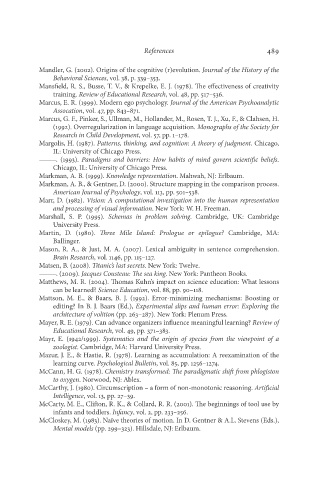Page 506 - Deep Learning
P. 506
References 489
Mandler, G. (2002). Origins of the cognitive (r)evolution. Journal of the History of the
Behavioral Sciences, vol. 38, p. 339–353.
Mansfield, R. S., Busse, T. V., & Krepelke, E. J. (1978). The effectiveness of creativity
training. Review of Educational Research, vol. 48, pp. 517–536.
Marcus, E. R. (1999). Modern ego psychology. Journal of the American Psychoanalytic
Assocation, vol. 47, pp. 843–871.
Marcus, G. F., Pinker, S., Ullman, M., Hollander, M., Rosen, T. J., Xu, F., & Clahsen, H.
(1992). Overregularization in language acquisition. Monographs of the Society for
Research in Child Development, vol. 57, pp. 1–178.
Margolis, H. (1987). Patterns, thinking, and cognition: A theory of judgment. Chicago,
IL: University of Chicago Press.
———. (1993). Paradigms and barriers: How habits of mind govern scientific beliefs.
Chicago, IL: University of Chicago Press.
Markman, A. B. (1999). Knowledge representation. Mahwah, NJ: Erlbaum.
Markman, A. B., & Gentner, D. (2000). Structure mapping in the comparison process.
American Journal of Psychology, vol. 113, pp. 501–538.
Marr, D. (1982). Vision: A computational investigation into the human representation
and processing of visual information. New York: W. H. Freeman.
Marshall, S. P. (1995). Schemas in problem solving. Cambridge, UK: Cambridge
University Press.
Martin, D. (1980). Three Mile Island: Prologue or epilogue? Cambridge, MA:
Ballinger.
Mason, R. A., & Just, M. A. (2007). Lexical ambiguity in sentence comprehension.
Brain Research, vol. 1146, pp. 115–127.
Matsen, B. (2008). Titanic’s last secrets. New York: Twelve.
———. (2009). Jacques Cousteau: The sea king. New York: Pantheon Books.
Matthews, M. R. (2004). Thomas Kuhn’s impact on science education: What lessons
can be learned? Science Education, vol. 88, pp. 90–118.
Mattson, M. E., & Baars, B. J. (1992). Error-minimizing mechanisms: Boosting or
editing? In B. J. Baars (Ed.), Experimental slips and human error: Exploring the
architecture of volition (pp. 263–287). New York: Plenum Press.
Mayer, R. E. (1979). Can advance organizers influence meaningful learning? Review of
Educational Research, vol. 49, pp. 371–383.
Mayr, E. (1942/1999). Systematics and the origin of species from the viewpoint of a
zoologist. Cambridge, MA: Harvard University Press.
Mazur, J. E., & Hastie, R. (1978). Learning as accumulation: A reexamination of the
learning curve. Psychological Bulletin, vol. 85, pp. 1256–1274.
McCann, H. G. (1978). Chemistry transformed: The paradigmatic shift from phlogiston
to oxygen. Norwood, NJ: Ablex.
McCarthy, J. (1980). Circumscription – a form of non-monotonic reasoning. Artificial
Intelligence, vol. 13, pp. 27–39.
McCarty, M. E., Clifton, R. K., & Collard, R. R. (2001). The beginnings of tool use by
infants and toddlers. Infancy, vol. 2, pp. 233–256.
McCloskey, M. (1983). Naïve theories of motion. In D. Gentner & A.L. Stevens (Eds.),
Mental models (pp. 299–323). Hillsdale, NJ: Erlbaum.

